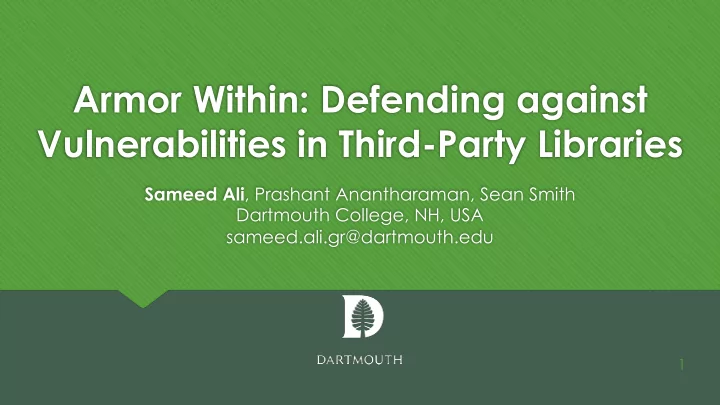

Armor Within: Defending against Vulnerabilities in Third-Party Libraries Sameed Ali , Prashant Anantharaman, Sean Smith Dartmouth College, NH, USA sameed.ali.gr@dartmouth.edu 1
Outline Motivation Our Evaluation Conclusions Approaches 2
Crafted input attacks on libraries Third-party library input not ● validated by main application App and library in same address ● space Otherwise secure software ● compromised by a crafted input attack on a third-party library 3
4
5
6
7
An example: CVE-2004-0597 The adversary tricks the browser into sending a malicious PNG file into the libPNG library. The exploited software module can then access sensitive information in other parts of the address space. 8
Outline Motivation Our Evaluation Conclusions Approaches 9
Proposed Solution 1. Compartmentalize application address space (via ELFbac) 2. LangSec validation applied to input of third-party software modules 3. Inject LangSec validation parser/filter in the software via a. Object rewriting b. Binary rewriting 4. Ensure CFI so validation not bypassed (via ELFbac policy) 10
CVE-2004-0597: LibPNG The adversary tricks the ● browser into sending a malicious PNG file into the libpng library. The exploited software ● module can then access sensitive information in other parts of the address space. 11
CVE-2004-0597: LibPNG The adversary tricks the ● browser into sending a malicious PNG file into the libpng library. The exploited software ● module can then access sensitive information in other parts of the address space. 12
CVE-2004-0597: LibPNG The adversary tricks the ● browser into sending a malicious PNG file into the libpng library. The exploited software ● module can then access sensitive information in other parts of the address space. 13
What does a LS parser/filter look like? 14
A simple PNG LS parser/filter using Hammer 15
Ensuring control flow integrity 16
Assumption: Constituent software modules compiled objects available Rewrite the Symbol table of the Filter Injection target object via object Library symbols point to with rewriting LangSec filter functions Link the objects together to generate the binary Inject ELFbac policy 17
Lift binary to LLVM IR code Insert LangSec validation filter via a Filter Injection custom LLVM IR pass via LLVM Compile LLVM to generate required binary Inject ELFbac policy 18
Outline Motivation Our Evaluation Conclusions Approaches 19
Evaluation To evaluate our system, we answer the following questions: Is Armor Within effective against known vulnerabilities? ● How much overhead do our LangSec filters add to existing binaries? ● Can Armor Within effectively inject parsers in existing binaries? ● 20
Evaluating against known vulnerabilities Armor Within was able to successfully detect and mitigate the following vulnerabilities: CVE-2016-1838: Denial-of-service heap-based buffer over-read ● vulnerability in LIBXML CVE-2004-0597: Stack-Overflow remote code execution vulnerability in ● LibPNG CVE-2010-1205: Buffer overflow in LibPNG ● We ran these experiments on a Desktop computer equipped with a Xeon E3-1245 processor and 8 Gigabytes of RAM. The computer ran Ubuntu Linux version 12.04 with the ELFbac Linux kernel patch. 21
Overheads added by our LangSec filters 22
Outline Motivation Our Evaluation Conclusions Approaches 23
Conclusions Armor Within comprises two techniques to inject LangSec parsers in binaries: Object rewriting Binary rewriting First technique is suited to dynamically linked libraries, whereas second technique works for statically linked libraries. Our tools were effective and added minimal overhead in terms of memory and CPU time to existing binaries. 24
Future Work Armor Within, works with Hammer parsers. We are working to make the ● tool more generic and can accept any parser combinator toolkit. For control-flow integrity, we used ELFbac in this paper. We are working ● to make our tools to be agnostic of the control-flow integrity techniques. We are working on a parser generator that converts BNF syntax to ● parser-combinator syntax. 25
Thank you! Questions? Sameed Ali sameed.ali.gr@dartmouth.edu Prashant pa@cs.dartmouth.edu Sean sws@cs.dartmouth.edu Code available at: https://bitbucket.org/sameed_ali/app-armor-poc/ 26
Acknowledgements This material is based upon work supported by the United States Air Force and DARPA under Contract No. FA8750-16-C-0179. Any opinions, findings and conclusions or recommendations expressed in this material are those of the author(s) and do not necessarily reflect the views of United States Government or any agency thereof. 27
Recommend
More recommend